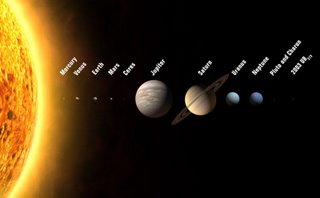Three new planets to join our solar system
 If gravity can make it round, it's a planet, planets also have to orbit a star, and not be either stars themselves or satellites of other planets – but the new part of the definition is roundness.Whereas very small heavenly bodies tend to be irregular rocks, larger ones are crushed by their own gravity into a spherical shape. The threshold size depends a bit on the material, but for ordinary ice or rock it turns out to be well below 1000 kilometres. So the new definition includes Ceres, previously classed as the largest asteroid, which is 950 kilometres across. Ceres would become the fifth planet from the Sun and the outermost of the five rocky planets, orbiting between Mars and Jupiter.Perhaps an even more surprising planet is Pluto's companion Charon. At more than 1000 kilometres across, it is certainly large enough to have settled into a sphere; and according to the new definition, Charon is not a satellite of Pluto.
If gravity can make it round, it's a planet, planets also have to orbit a star, and not be either stars themselves or satellites of other planets – but the new part of the definition is roundness.Whereas very small heavenly bodies tend to be irregular rocks, larger ones are crushed by their own gravity into a spherical shape. The threshold size depends a bit on the material, but for ordinary ice or rock it turns out to be well below 1000 kilometres. So the new definition includes Ceres, previously classed as the largest asteroid, which is 950 kilometres across. Ceres would become the fifth planet from the Sun and the outermost of the five rocky planets, orbiting between Mars and Jupiter.Perhaps an even more surprising planet is Pluto's companion Charon. At more than 1000 kilometres across, it is certainly large enough to have settled into a sphere; and according to the new definition, Charon is not a satellite of Pluto.Charon is so heavy that the centre of gravity of the two bodies is in space, between the two objects (whereas the Earth and Moon orbit each other about a point deep inside the Earth, making the Moon a true satellite). Pluto and Charon would become the first double planet in the solar system. In 2005 came the killer: the object designated 2003 UB313, popularly known as Xena, is 2400 kilometres across, making it slightly bigger than Pluto.A new term has been invented for Pluto, Charon, Xena and any other distant planet with an orbit that takes more than 200 years: They will be called "plutons" (though geologists might be a little peeved that their word for an igneous intrusion has been appropriated). Most new planets would be plutons; there are already several candidates, and perhaps a few dozen will be found altogether.
0 Comments:
Post a Comment
<< Home